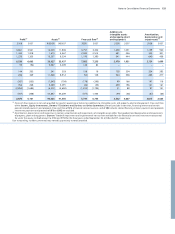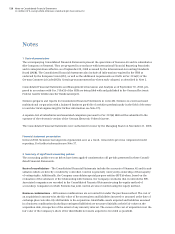Siemens 2008 Annual Report Download - page 227
Download and view the complete annual report
Please find page 227 of the 2008 Siemens annual report below. You can navigate through the pages in the report by either clicking on the pages listed below, or by using the keyword search tool below to find specific information within the annual report.
Notes to Consolidated Financial Statements 131
(in millions of €, except where otherwise stated and per share amounts)
Financial instruments – A nancial instrument is any contract that gives rise to a nancial asset of one entity
and a nancial liability or equity instrument of another entity. Financial assets of the Company mainly include
cash and cash equivalents, available-for-sale nancial assets, trade receivables, loans receivable, nance lease
receivables and derivative nancial instruments with a positive fair value. Cash and cash equivalents are not
included within the category available-for-sale nancial assets as these nancial instruments are not subject to
value uctuation within the company. Siemens does not make use of the category held to maturity. Financial
liabilities of the Company mainly comprise notes and bonds, loans from banks, commercial paper, trade pay-
ables, nance lease payables and derivative nancial instruments with a negative fair value. Siemens does not
make use of the option to designate nancial assets or nancial liabilities at fair value through prot or loss at
inception (Fair Value Option). Based on their nature, nancial instruments are classied as nancial assets and
nancial liabilities measured at cost or amortized cost and nancial assets and nancial liabilities measured
at fair value. See Notes 31 and 32 for further information.
Financial instruments are recognized on the balance sheet when Siemens becomes a party to the contractual
obligations of the instrument. For regular way purchases or sales of nancial assets, i.e. purchases or sales
under a contract whose terms require delivery of the asset within the time frame established generally by regu-
lation or convention in the marketplace concerned, the trade date is applied.
Initially, nancial instruments are recognized at their fair value. Transaction costs directly attributable to the
acquisition or issue of nancial instruments are only recognized in determining the carrying amount, if the
nancial instruments are not measured at fair value through prot or loss. Finance lease receivables are recog-
nized at an amount equal to the net investment in the lease. Subsequently, nancial assets and liabilities are
measured according to the category – cash and cash equivalents, available-for-sale nancial assets, loans and
receivables, nancial liabilities measured at amortized cost or nancial assets and liabilities classied as held
for trading – to which they are assigned.
Cash and cash equivalents – The Company considers all highly liquid investments with less than three months
maturity from the date of acquisition to be cash equivalents. Cash and cash equivalents are measured at cost.
Available-for-sale nancial assets – Investments in equity instruments, debt instruments and fund shares are
all classied as available-for-sale nancial assets. They are accounted for at fair value if reliably measurable,
with unrealized gains and losses included in Other components of equity, net of applicable deferred income
taxes. Equity instruments that do not have a quoted market price in an active market and whose fair value cannot
be reliably measured are recorded at cost.
When available-for-sale nancial assets incur a decline in fair value below acquisition cost and there is objective
evidence that the asset is impaired, the cumulative loss that has been recognized in equity is removed from
equity and recognized in the Consolidated Statements of Income. The Company considers all available evidence
such as market conditions and prices, investee-specic factors and the duration and the extent to which fair
value is less than acquisition cost in evaluating potential impairment of its available-for-sale nancial assets.
An impairment loss may be reversed in subsequent periods for debt instruments, if the reasons for the impair-
ment no longer exist.
Loans and receivables – Financial assets classied as loans and receivables are measured at amortized cost
using the effective interest method less any impairment losses. Impairment losses on trade and other receiv-
ables are recognized using separate allowance accounts. See Note 3 for further information regarding the deter-
mination of impairment. Loans and receivables bearing no or lower interest rates compared to market rates with
a maturity of more than one year are being discounted.
























